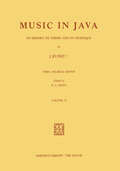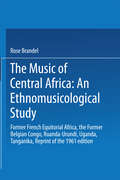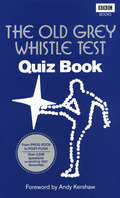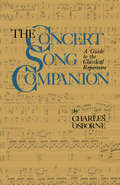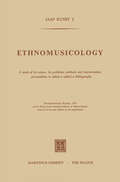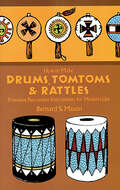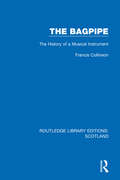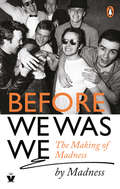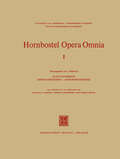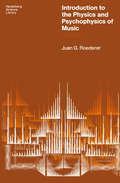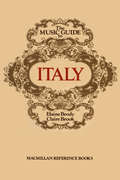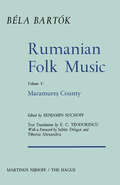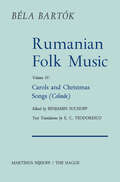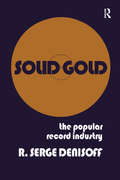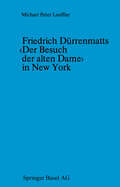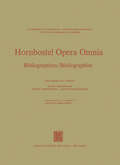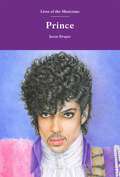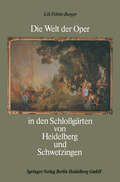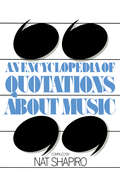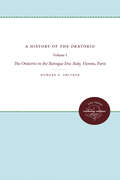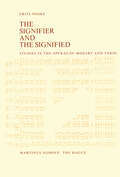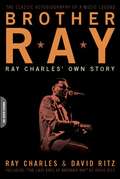- Table View
- List View
The Music of Central Africa: Former French Equatorial Africa the Former Belgian Congo, Ruanda-Urundi Uganda, Tanganyika
by R. BrandelUnder the inspiring guidance of my mentor, Curt Sachs, this work was conceived, planned, and executed. It gained in dimension under the acute and patient perusal of Gustave Reese to whose brilliant propensity for clarity of thought and of style lowe a huge debt. Furthermore, the helpful suggestions made by Martin Bernstein and by Jan LaRue are gratefully acknowledged. If Jaap Kunst had not kindly gone to the trouble of ordering, supervising the con struction of, and mailing to me from Amsterdam his personally designed monochord, an important section of this work could not have taken form. This preface is not complete, of course, without final thanks to my husband, Harvey B. N atanson, for his sustained interest and encouragement. R. B. Note As the present work goes to press, the political map of Africa is flowing into a new mold. Several countries have obtained independence, and new names and data should be con sidered: French Equatorial Africa has become (November 28-December I, 1958) four independent countries - Republic of the Congo: Brazzaville (formerly Middle Congo), Gabon Republic (formerly Gabon), Central African Republic (formerly Ubangi-Shari), and Republic of Chad (formerly Chad). The Belgian Congo has become (June 30, 1960) the Republic of the Congo: Leopoldville.
The Old Grey Whistle Test Quiz Book
by Mark PaytressBob Dylan. Tom Waits. Blondie. The Ramones. REM. The Who. Fleetwood Mac. Led Zeppelin. The list goes on and on.The Old Grey Whistle Test has played host to some of the biggest names in music and has assumed its rightful place at the pinnacle of rock history - but how much of a fan are you?Do you know your Bowie backlist? Could your knowledge of Lennon long-players stand up to scrutiny? And can you tell your glam rock from your hair metal? This collection delves deep into the Whistle Test archives to pose over 2,500 quiz questions on your favourite artists, from global megastars to obscure one-time guests on the show. Play in teams or test your own knowledge on questions covering a whole range of musical puzzles, from lost albums and banned songs to classic solos, one-hit wonders and more.
The Concert Song Companion: A Guide to the Classical Repertoire (Quality Paperbacks Ser.)
by Charles OsborneW HAT I H A V E attempted in this book is a survey of song; the kind of song which one finds variously described as 'concert', 'art', or sometimes even 'classical song'. 'Concert song' seems the most useful, certainly the least inexact or misleading, of some descriptions, especially since 'art song' sounds primly off putting, and 'classical song' really ought to be used only to refer to songs written during the classical period, i. e. the 18th century. Concert song clearly means the kind of songs one hears sung at concerts or recitals. Addressing myself to the general music-lover who, though he possesses no special knowledge of the song literature, is never theless interested enough in songs and their singers to attend recitals of Lieder or of songs in various languages, I have naturally confined myself to that period of time in which the vast majority of these songs was composed, though not necessarily only to those composers whose songs have survived to be remembered in recital programmes today. I suppose this to be roughly the three centuries covered by the years 1650-1950, though most of the songs we, as audiences, know and love were composed in the middle of this period, in other words in the 19th century.
Ethnomusicology: A study of its nature, its problems, methods and representative personalities to which is added a bibliography
by E.D KunstThis booklet hardly needs a preface; the contents, I think. speak for themselves.It contains a short and carefully brought up to date resume of all that I. as a private University Lecturer in Amsterdam. have tried to teach my pupils. It is intended as a general introduction to ethnomusicology, before going on to the study of the forms of separate music-cultures. I sincerely hope that those, who wish to teach themselves and to qualify in this branch of knowledge, will find a satisfactory basis for selftuition in the matter here brought together. Regarding the possibility of a new edition, any critical remarks or infor mation as to possible desiderata would be very gratefully received. J.K. PREFACE TO THE SECOND EDITION My request for critical remarks and desiderata has not been ignored. My sincere thanks to all who took the trouble to let me know what they missed in my booklet. Through their collaboration the contents have undergone a considerable improvement and enlargement as compared to the original edition issued in 1950 by the Royal Tropical Institute, Amsterdam. under the title 'Musicologica'. I have taken care to add many particulars from non-European sources. with the result that now the book is no longer so Europe-centric as it was. Furthermore, I have done my best to mention in a special bibliography all the more important ethnomusicological publications, with the exception of those issued in the Russian, Arabic. Chinese, Indonesian, Javanese.
How to Make Drums, Tomtoms and Rattles: Primitive Percussion Instruments for Modern Use
by Bernard MasonMaking your own primitive instruments from simple materials such as coffee cans and flower pots. Includes 121 figures.
The Bagpipe: The History of a Musical Instrument (Routledge Library Editions: Scotland #9)
by Francis CollinsonOriginally published in 1975, and written by an authority on Scottish music, this book traces the evolution of the bagpipe whilst also narrating the fortunes of the ‘Great Highland Bagpipe’ itself. Exploring history and archaeology of civilizations as far removed from the Scottish Highlands as Egypt and Mesopotamia, Greece and Rome this book offers a unique full-length history of one of the world’s most interesting and ancient musical instruments. Appendices list the bagpipes of other countries and the materials used in the instrument’s manufacture as well as a comprehensive bibliography.
The Bagpipe: The History of a Musical Instrument (Routledge Library Editions: Scotland #9)
by Francis CollinsonOriginally published in 1975, and written by an authority on Scottish music, this book traces the evolution of the bagpipe whilst also narrating the fortunes of the ‘Great Highland Bagpipe’ itself. Exploring history and archaeology of civilizations as far removed from the Scottish Highlands as Egypt and Mesopotamia, Greece and Rome this book offers a unique full-length history of one of the world’s most interesting and ancient musical instruments. Appendices list the bagpipes of other countries and the materials used in the instrument’s manufacture as well as a comprehensive bibliography.
Before We Was We: Madness by Madness
by Lee Thompson Mike Barson Mark Bedford Chris Foreman Graham McPherson Cathal Smyth Dan WoodgateIn Before We Was We, their first official book, Madness tell us how they became them. A story of seven originals, whose collective graft, energy and talent took them from the sweaty depths of the Hope & Anchor's basement to the Top of the Pops studio. In their own words they each look back on their shared adventures. Playing music together, riding freight trains, spraying graffiti and stealing records. Walking in one another's footsteps by day and rising up through the city's exploding pub music scene by night. Before We Was We is irreverent, funny and full of character. Just like them.
Hornbostel Opera Omnia (Hornborstel Opera Omnia #1)
by K. P. Wachsmann D. Christensen H. P. ReineckeIntroduction to the Physics and Psychophysics of Music (Heidelberg Science Library #Vol. 16)
by Juan G. RoedererRumanian Folk Music: Carols and Christmas Songs (Colinde) (Bartok Archives Studies in Musicology #4)
by Bela Bartokn the first volume of Rumanian Folk Music (Instrumental Melodies) I portions of Bela Bart6k's subsequently-discarded preface, concern ing the fate of his folklore publications, are presented in explanation of the editorial processes necessary for achieving the publication. 1 By way of introduction to this revised edition of a previous, although in complete, published version of the Rumanian Carols and Christmas Songs (Colinde), we refer again to the author's suppressed lines which pertain to this volume: The second publication by the same publisher was to include my collection of Rumanian Colindas (Winter-solstice songs). Their extremely interesting texts were supposed to appear in original as well as in English. After several years of delay, the translation to English prose was completed, one part in adequate archaic English, the rest (by someone else) in most unsuitable Kitchen-English. The publisher did not wish to change this, though. Result: I published the book at my own expense; however, only the musical part, because of lack of sufficient funds. The texts are still in manuscript, even today. 2 Our primary aim, therefore, has been to unite the Rumanian poetic texts and translations with the musical part, in one volume, as was the desire of the author.
Solid Gold: Popular Record Industry
by R. Serge DenisoffMore than 90 record companies release over 9,000 pop records each year-a staggering total of 52,000 songs. Each one competes for the gold record, the recording industry's symbol of success that certifies $1 million worth of records have been sold. Solid Gold explains why, for each record that succeeds, countless others fail. This book follows the progress of a record through production, marketing, and distribution, and shows how a mistake made at any point can mean its doom. Denisoff suggests that a drastic shift in the demographic makeup of the pop music audience during the sixties has resulted in a broader listening public, including fans at every level of society.
Solid Gold: Popular Record Industry
by R. Serge DenisoffMore than 90 record companies release over 9,000 pop records each year-a staggering total of 52,000 songs. Each one competes for the gold record, the recording industry's symbol of success that certifies $1 million worth of records have been sold. Solid Gold explains why, for each record that succeeds, countless others fail. This book follows the progress of a record through production, marketing, and distribution, and shows how a mistake made at any point can mean its doom. Denisoff suggests that a drastic shift in the demographic makeup of the pop music audience during the sixties has resulted in a broader listening public, including fans at every level of society.
Friedrich Dürrenmatts ‹Der Besuch der alten Dame› in New York: Ein Kapitel aus der Rezeptionsgeschichte der neueren Schweizer Dramatik
by LOEFFLERHornbostel Opera Omnia: Bibliographien / Bibliographies (Hornborstel Opera Omnia #2)
by K. P. Wachsmann D. Christensen H. P. ReineckePrince (Lives of the Musicians)
by Jason DraperHis name was Prince, and he was funky. He was also inspiring, infuriating, visionary and otherworldly. Channelling contradictions in search of his own unique truth, he eventually changed his name to an unpronounceable glyph that merged the male and female symbols in an outward expression of his inner dualities. Gifted with the ability to play almost every instrument on his records, and shifting between musical styles as much as he switched-up his looks, he refused to acknowledge boundaries. Instead, he brought opposing forces together in a life-long quest to reconcile a dirty mind with a love for God. In doing so, the mini Minneapolis genius became a world-conquering icon whose towering legacy continues to shape pop culture.
An Encyclopedia of Quotations About Music
by Nat ShapiroWriting about music-about what it is and what it means-is akin to describing the act of love. Somehow, the reduction of the experience to an unblushingly detailed exposition of how, where, when, and why who does what to whom, from prelude to resolu tion, loses everything in the translation. The other extreme, the one wherein the writer, in desperation, resorts to metaphor (with or without benefit of meter and rhyme), most often results in im agery that is banal, vulgar, inane, obscure, pretentious, and almost always insufferably romantic. To achieve good and accurate writing about music is as rare an accomplishment as expert wine-tasting, lion-taming, diamond-cut ting, truffie-finding and (if one just happens to be an unconverted Mohican brave) deer-tracking. Only the intuitive, the pure, the sensual, and the intrepid need apply. Professional musicians often evidence a fixed tendency either to rudely ignore or else to actively despise those of us who bravely try to understand, define, and describe their art. To many composers and instrumentalists, those outsiders (nonmusicians) who have the temerity to discuss anything more abstract than the digital dexterity of a fiddler, the particular vanity of a conductor, or the wage scales for overtime recording sessions are judged worthy only of contempt or-at the most-patronizing tolerance. "Music means itself," insists one of the contributors to the collection that follows, and many practitioners of the art of organ ized sound would prefer to leave it at that.
A History of the Oratorio: Vol. 1: The Oratorio in the Baroque Era: Italy, Vienna, Paris
by Howard E. SmitherHoward Smither has written the first definitive work on the history of the oratorio since Arnold Schering published his Geschichte des Oratoriums in 1911. This volume is the first of a four-volume comprehensive study that offers a new synthesis of what is known to date about the oratorio.Volume 1, divided into three parts, opens with the examination of the medieval, Renaissance, and early Baroque antecedents and origins of the oratorio, with emphasis on Rome and Philip Neri's Congregation of the Oratory and with special attention to the earliest works for which the term oratorio seems appropriate. The second part recounts the development of the oratorio in Italy, circa 1640-1720. It reviews the social contexts, patrons, composers, poets, librettos, and music of the oratorio in Italy, especially in Vienna and Paris. The procedure adapted throughout the work is to treat first the social context, particularly the circumstances of performance of the oratorio in a given area and period, then to treat the libretto, and finally the music. For each geographic area and period, the author has selected for special attention a few oratorios that appear to be particularly important or representative. He has verified the information offered in the specialized literature whenever possible by reference to the music or documents. In a number of areas, particular seventeenth-century Italy, in which relatively few previous studies have been undertaken or secondary sources have proven to be inadequate, the author has examined the primary sources in manuscript and printed form -- music, librettos, and documents of early oratorio history. Impressive research and intelligent integration of disparate elements make this complicated, diffuse subject both readable and accessible to the student of music.Volume 2, The Oratorio in the Baroque Era: Protestant Germany and England, and Volume 3, The Oratorio in the Classical Era, continue and expand the study of oratorio history. Although this series was originally announced as a three-volume study, Smither will conclude with a fourth volume.This new work--the first English-language study of the history of the oratorio will become the standard work on its subject and an enduring contribution to music and scholarship.Originally published in 1977.A UNC Press Enduring Edition -- UNC Press Enduring Editions use the latest in digital technology to make available again books from our distinguished backlist that were previously out of print. These editions are published unaltered from the original, and are presented in affordable paperback formats, bringing readers both historical and cultural value.
Music and the Brain: Studies in the Neurology of Music
by MACDONALD CRITCHLEY, R.A. HENSONMusic and the Brain: Studies in the Neurology of Music is a collaborative work that discusses musical perception in the context of medical science. The book is comprised of 24 chapters that are organized into two parts. The first part of the text details the various aspects of nervous function involved in musical activity, which include neural and mechanicals aspects of singing; neurophysiological interpretation of musical ability; and ecstatic and synesthetic experiences during musical perception. The second part deals with the effects of nervous disease on musical function, such as musicogenic epilepsy, the amusias, and occupational palsies. The book will be of great interest to students, researchers, and practitioners of disciplines that deal with the nervous system, such as psychology, neurology, and psychiatry.
The Signifier and the Signified: Studies in the Operas of Mozart and Verdi
by F. NoskeThe studies collected in this volume deal with the interpretation of opera. In most cases the results are based on structural analysis, a concept which may require some clarification in this context. During the past de cade 'structure' and 'structural' have become particularly fashionable terms lacking exact denotation and used for the most divergent purposes. As employed here, structural analysis is concerned with such concepts as 'relationship', 'coherence' and 'continuity', more or less in contrast to formal analysis which deals with measurable material. In other words, I have analysed the structure of an opera by seeking and examining factors in the musico-dramatic process, whereas analysts of form are generally preoccupied with the study of elements contained in the musical object. Though admittedly artificial, the dichotomy of form and structure may elucidate the present situation with regard to the study of opera. Today, nearly one hundred years after the death of Wagner, the proclaimed anti thesis of Oper und Drama is generally taken for what it really was: a means to propagate the philosophy of its inventor. The conception of opera (whether 'continuous' or composed of 'numbers') as a special form of drama is no longer contested. Nevertheless musical scholarship has failed to draw the consequences from this view and few scholars realize the need to study general theory of drama and more specifically the dramatic experience.
Brother Ray: Ray Charles' Own Story
by David Ritz Ray CharlesRay Charles (1930-2004) led one of the most extraordinary lives of any popular musician. In Brother Ray, he tells his story in an inimitable and unsparing voice, from the chronicle of his musical development to his heroin addiction to his tangled romantic life. Overcoming poverty, blindness, the loss of his parents, and the pervasive racism of the era, Ray Charles was acclaimed worldwide as a genius by the age of thirty-two. By combining the influences of gospel, jazz, blues, and country music, he invented, almost single-handedly, what became known as soul. And throughout a career spanning more than a half century, Ray Charles remained in complete control of his life and his music, allowing nobody to tell him what he could and couldn't do.As the Chicago Sun-Times put it, Brother Ray is "candid, explicit, sometimes embarrassing, often hilarious, always warm, touching and deeply human-just like his music."
